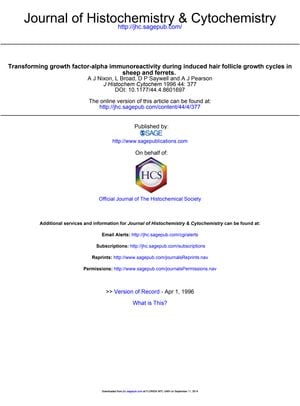Transforming growth factor-alpha immunoreactivity during induced hair follicle growth cycles in sheep and ferrets.
April 1996
in “
Journal of histochemistry and cytochemistry/The journal of histochemistry and cytochemistry
”
Transforming growth factor-alpha TGF-alpha hair follicle growth melatonin anagen phase catagen phase telogen phase proanagen phase outer root sheath cortical cells inner root sheath dermal papilla sebaceous glands epidermis Western blot immunoreactivity TGF-alpha hair growth cycle melatonin growth phases skin layers Western blot

TLDR TGF-alpha is present in sheep and ferret skin and may affect hair growth without directly stimulating cell proliferation.
In the 1996 study, researchers investigated the role of Transforming growth factor-alpha (TGF-alpha) in hair follicle growth by examining its immunocytochemical localization and relationship with cell proliferation markers in the skin of melatonin-treated ferrets and untreated Romney and New Zealand Wiltshire sheep. They found that TGF-alpha immunoreactivity was present in the epithelial tissues of the skin but did not overlap with cell proliferation markers. During the anagen phase of the hair cycle, TGF-alpha was most intense in the innermost cells of the outer root sheath and cortical cells, but absent from the inner root sheath and dermal papilla. The immunoreactivity decreased during the catagen phase and was faint or restricted in the telogen and early proanagen phases, with a reestablishment in the late proanagen phase. Sebaceous glands and epidermis showed intense staining throughout the hair cycle. Western blot analysis of skin extracts indicated the presence of TGF-alpha-immunoreactive components with a molecular weight of approximately 32 KD. These findings suggest that TGF-alpha may have an autocrine or juxtacrine role in the epithelium, rather than a direct role in stimulating cell proliferation.
